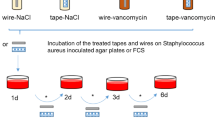Abstract
Background
Surgical suture materials are accepted to be associated with a substantial proportion of surgical site infections. These infections are related with biofilm formation similar to that of other synthetic and implantable medical devices.
Methods
We conducted an in vitro study to investigate the bacterial adherence to different types of braided surgical sutures. The included sutures were polyglactin (Vicryl®) group (VG), rapidly absorbable polyglactin (Rapide-Vicryl®) group (RVG), nitrofurazone-coated polyglactin (Vicryl®) group (FVG), polyethylene terephthalate (Etibond®) group (EG), and natural silk (Silk®) group (SG). All sutures were cut in 1 cm length, embedded into tryptic soy broth, and then 106-CFU/ml Escherichia coli and Staphylococcus aureus were added. After the 24th and 96th hour of incubation, bacterial colonies were counted, and results were expressed as CFU/cm.
Results
E.coli adhesion was significantly lower in VG and significantly higher in SG compared to FVG, RVG, and EG at the 24th and 96th hour of cultivation (p < 0.05). The S.aureus adhesion results at 24th hour showed that VG had the least bacterial adhesion, and FVG had the most bacterial adhesion compared to other sutures (p < 0.05). The S.aureus adhesion results at the 96th hour of cultivation showed that bacterial adhesion on sutures was not significantly different between groups (p > 0.05).
Conclusion
Of all braided surgical sutures, bacterial adhesion is significantly lower in polyglactin and significantly higher in silk sutures. Nitrofurazone coverage of suture worsens S.aureus contamination of the suture.
Level of Evidence: Not ratable


Similar content being viewed by others
References
Klevens RM, Edwards JR, Richards CL Jr, Horan TS, Gaynes RP, Pollock DA et al (2007) Estimating health care-associated infections and deaths in U.S. hospitals, 2002. Public Health Rep 122:160–166
Hess DJ, Henry-Stanley MJ, Wells CL (2011) Gentamicin promotes Staphylococcus aureus biofilms on silk suture. J Surg Res 170:302–308
Henry-Stanley MJ, Hess DJ, Barnes AM, Dunny GM, Wells CL (2010) Bacterial contamination of surgical suture resembles a biofilm. Surg Infect 11:433–439
Edmiston CE, Seabrook GR, Goheen MP, Krepel CJ, Johnson CP, Lewis BD et al (2006) Bacterial adherence to surgical sutures: can antibacterial-coated sutures reduce the risk of microbial contamination? J Am Coll Surg 203:481–489
Bozic DD, Milenkovic M, Ivkovic B, Cirkovic I (2014) Newly-synthesized chalcones-inhibition of adherence and biofilm formation of methicillin-resistant Staphylococcus aureus. Braz J Microbiol 45:263–270
Oliveira M, Dias FR, Pomba C (2014) Biofilm and fluoroquinolone resistance of canine Escherichia coli uropathogenic isolates. BMC Res Notes 7:499
Masini BD, Stinner DJ, Waterman SM, Wenke JC (2011) Bacterial adherence to suture materials. J Surg Educ 68:101–104
Fowler JR, Perkins TA, Buttaro BA, Truant AL (2013) Bacteria adhere less to barbed monofilament than braided sutures in a contaminated wound model. Clin Orthop Relat Res 471:665–671
Soyer T, Bostanoglu E, Aslan MK, Boybeyi Ö, Demirbilek M, Göçmen JS (2014) In vitro evaluation of E. coli and S. epidermidis adhesion on dressing materials used in hypospadias repair. Eur J Plast Surg 37:63–68
Rad AY, Ayhan H, Piskin E (1998) Adhesion of different bacterial strains to low-temperature plasma-treated sutures. J Biomed Mater Res 41:349–358
Katz S, Izhar M, Mirelman D (1981) Bacterial adherence to surgical sutures. Ann Surg 194:35–41
Javed F, Al-Askar M, Almas K, Romanos GE, Al-Hezaimi K (2012) Tissue reactions to various suture materials used in oral surgical interventions. ISRN Dent. doi:10.5402/2012/762095
Abi Rached RS, de Toledo BE, Okamoto T, Marcantonio Júnior E, Sampaio JE, Orrico SR et al (1992) Reaction of the human gingival tissue to different suture materials used in periodontal surgery. Braz Dent J 2:103–113
Hess DJ, Henry-Stanley MJ, Wells CL (2012) Interplay of antibiotics and bacterial inoculum on suture-associated biofilms. J Surg Res 177:334–340
Hoshino S, Yoshida Y, Tanimura S, Yamauchi Y, Noritomi T, Yamashita Y (2013) A study of the efficacy of antibacterial sutures for surgical site infection: a retrospective controlled trial. Int Surg 98:129–132
Hess DJ, Henry-Stanley MJ, Lusczek ER, Beilman GJ, Wells CL (2013) Anoxia inhibits biofilm development and modulates antibiotic activity. J Surg Res 184:488–494
Author information
Authors and Affiliations
Corresponding author
Ethics declarations
Conflict of interest
Özlem Boybeyi, Birgül Kaçmaz, Yasemin Dere Günal, Serdar Gül, Serap Yörübulut, Mustafa Kemal Aslan declare that they have no conflict of interest.
Ethical standards
This article does not contain any studies with human participants or animals performed by any of the authors.
Funding
There was no funding received for this work.
Rights and permissions
About this article
Cite this article
Boybeyi, Ö., Kaçmaz, B., Günal, Y.D. et al. Bacterial adhesion to braided surgical sutures: an in vitro study. Eur J Plast Surg 39, 1–6 (2016). https://doi.org/10.1007/s00238-015-1171-5
Received:
Accepted:
Published:
Issue Date:
DOI: https://doi.org/10.1007/s00238-015-1171-5




